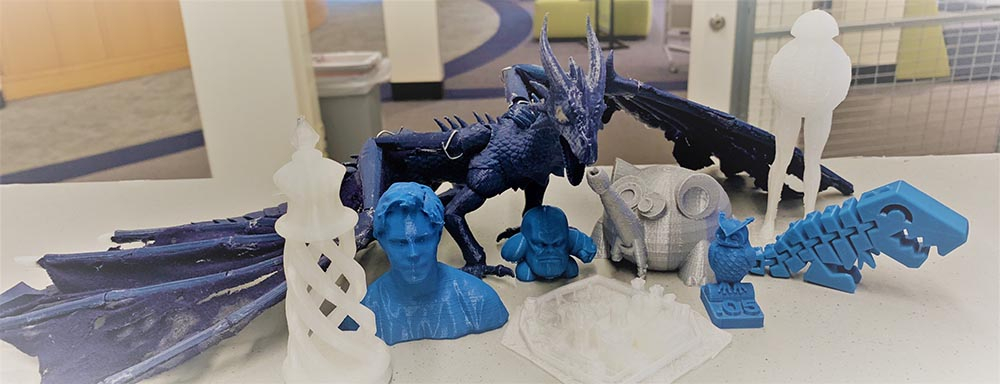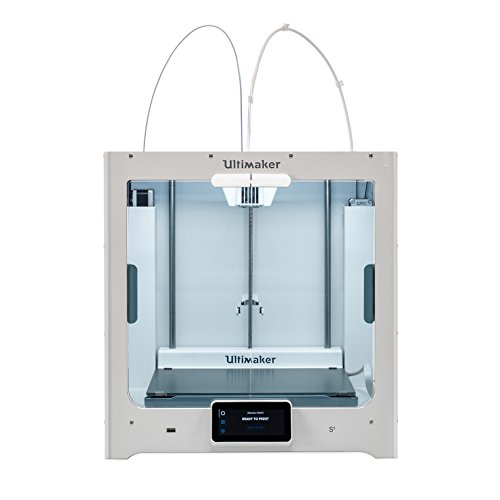3D Printing
The Student Technology Center is equipped with three Ultimaker S3 printers, made available for use by students, faculty, and staff through the Student Technology Fee and in collaboration with the WWU Makerspace Club. 3D Printing allows for "rapid prototyping" as well as custom designing of tools, toys, replacement parts, and more!

How can I 3D print at the STC?
This video explains the basic process of 3D printing through the STC.
Everyone with a Western ID is allotted 25 grams of filament per quarter. Students can purchase more through the eMarket by navigating to WWU Makerspace Club and selecting the "PLA Filament Allotment" item. It is $2.50 for 100g of filament. We are only allowed to use PLA on library premises.
We highly recommend enrolling in the Engineering & Design Makerspace's Canvas course and following their 3D Printing Badge, but it is not required. STC staff will help you slice the file and start your print if you have any questions.
To request 3D printing through the STC, you can use this 3D Printing Survey form. You will need to email your model file to techcenter@wwu.edu
While our printers can handle most prints, there are some things that are more difficult than others. Small models and figurines (ie, tabletop RPG's) with a high level of detail are one example of this - we can attempt these, but we cannot guarantee that the print will be successful or come out perfectly. Often times these are made on resin or SLA printers, which is different than the FDM style available in the STC.
What Can I 3D Print?
Students are allowed to print anything they want within reason. Some examples of unacceptable prints include:
- Firearms or Dangerous Weapons
- Pornographic Images or Designs
- Copyrighted or Protected Property
To find a model to 3D print, we recommend several websites:
We also have our very own file repository through WordPress, curated by Western student volunteers and employees - the Maker's Trove! This has files and templates either sourced by or created by Western students and made available to share and promote their work.
For those interested, Makerspace Student Manager Taylor Inman has written a high level overview of our general capabilities regarding 3D Printing.
How do the printers work?
Our 3D printers use the Fused Deposition Modeling (FDM) technique. The simplified process is as follows:
- A 3D model is put into a program known as a slicer, which translates the model into hundreds of thin "layers" that are placed one on top of the other.
- After the model has been sliced, it is saved as a GCode file onto an SD card, which the printer is able to read. The file includes complex and meticulous instructions for the printer's hotend, which is mounted onto two moving axes.
- The extruder pushes plastic filament through a tube leading to the hotend, which melts the plastic at approximately 210 degrees celcius. The molten plastic is then pushed through a nozzle, which deposited it onto a heated glass surface according to the instructions provided by the GCode file.
- The glass buildplate is also mounted on an axis, which moves down in tiny increments after each layer has been completed.
If you want to learn more about the process, there are dozens of YouTube videos with tons of information! This video shows a hypnotizing timelapse of an Ultimaker-2 at work.

How long does it take?
The FDM process tends to be fairly slow by nature. Depending on size and level of detail, prints can take anywhere from 5 minutes to as long as multiple days! At the STC we are only able to operate the printers during our business hours, so typically we do prints in the range of 1-6 hours. Print time can be reduced at the sacrifice of infill (which improves durability) and/or resolution (quality). Models can also be divided into multiple parts to be printed simultaneously and later glued or epoxied together.